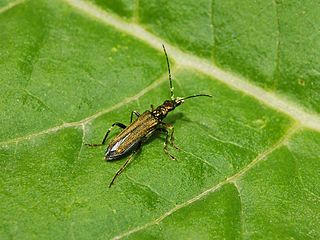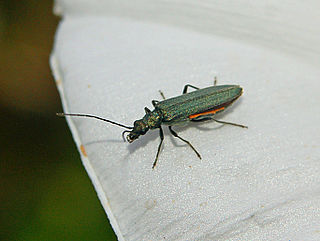
The insects of the beetle family Chrysomelidae are commonly known as leaf beetles, and include over 37,000 species in more than 2,500 genera, making up one of the largest and most commonly encountered of all beetle families. Numerous subfamilies are recognized, but the precise taxonomy and systematics are likely to change with ongoing research.

Polyphaga is the largest and most diverse suborder of beetles. It comprises 144 families in 16 superfamilies, and displays an enormous variety of specialization and adaptation, with over 350,000 described species, or approximately 90% of the beetle species so far discovered.

Darkling beetle is the common name of the large family of beetles Tenebrionidae. The number of species in the Tenebrionidae is estimated at more than 20,000 and the family is cosmopolitan in distribution.

The Archaeognatha are an order of apterygotes, known by various common names such as jumping bristletails. Among extant insect taxa they are some of the most evolutionarily primitive; they appeared in the Middle Devonian period at about the same time as the arachnids. Specimens that closely resemble extant species have been found as both body and trace fossils in strata from the remainder of the Paleozoic Era and more recent periods. For historical reasons an alternative name for the order is Microcoryphia.
The arthropod leg is a form of jointed appendage of arthropods, usually used for walking. Many of the terms used for arthropod leg segments are of Latin origin, and may be confused with terms for bones: coxa, trochanter, femur, tibia, tarsus, ischium, metatarsus, carpus, dactylus, patella.

Cleridae are a family of beetles of the superfamily Cleroidea. They are commonly known as checkered beetles. The family Cleridae has a worldwide distribution, and a variety of habitats and feeding preferences.

The Aderidae, sometimes called ant-like leaf beetles, are a family of beetles that bear some resemblance to ants. The family consists of about 1,000 species in about 50 genera, of which most are tropical, although overall distribution is worldwide.

Oedemera is a genus of beetles of the family Oedemeridae, subfamily Oedemerinae.

Oedemera nobilis, also known as the false oil beetle, thick-legged flower beetle or swollen-thighed beetle, is a beetle in the family Oedemeridae, a common species in Western Europe, including the south of England.

Belinae are a Gondwanan subfamily of beetles which belong to the belids, primitive weevils of the family Belidae. Like in other belids, their antennae are straight, not elbowed as in the true weevils (Curculionidae). The Belinae make up the bulk of the diversity of living belid genera. They are found in the Australia-New Guinea-New Zealand and South America.
Carcineretidae is a prehistoric family of heterotrematan crustaceans. They are only known from Cretaceous fossils. These crabs are tentatively placed in the superfamily Portunoidea and resemble the swimming crabs (Portunidae) in having some paddle-shaped pereiopods. But it is not certain that this placement is correct, as the Carcineretidae also show some similarities to the Matutidae of superfamily Leucosioidea and the Goneplacidae of superfamily Xanthoidea.

Oedemera atrata is a species of beetle belonging to the family Oedemeridae subfamily Oedemerinae.

Oedemera flavipes is a very common species of beetle of the family Oedemeridae, subfamily Oedemerinae.

Cebrionini is a tribe of click beetles from the family Elateridae; formerly ranked as a subfamily or family, they are now considered a tribe within the subfamily Elaterinae.

Oedemera lurida is a species of beetle belonging to the family Oedemeridae subfamily Oedemerinae.

Oedemera podagrariae, common name false blister beetle, is a quite common species of beetles belonging to the family Oedemeridae subfamily Oedemerinae.

Bruchidius siliquastri is a species of bean weevil. It was first found in pods of Cercis siliquastrum in China, and has thence been found in several continents. Its length ranges from 2.8 to 3.7 millimetres. Its body is short and ovate, with a black integument. The apex of its femora and the ventral part of its hind tarsi are reddish. Its vestiture is made of thin and short setae; dorsally setae are a whitish colour, denser on the scutellum. Its pygidium is also covered with setae. Its name is derived from its host plant.

Dermestes ater is a species of beetle in the family Dermestidae, the skin beetles. It is known commonly as the black larder beetle or incinerator beetle. It is native to North America, but today it is found nearly worldwide. Like several other dermestid beetles, this species is a common pest of stored products.
Eustra shanghaiensis, is a species of flanged bombardier beetle belonging to the family Carabidae. It is endemic to China.

Epimetopidae is a family of semi-aquatic beetles found on the edges of streams and shallow freshwater ponds. These beetles are shorter than half a centimeter long and have a pronotum with a central projection forming a shelf above the head. On the underside of the abdomen only four sternites are visible. There are less than a hundred species in three genera, Epimetopus which is restricted to the New World, mostly Neotropical, Eupotemus with two Afrotropical species and Eumetopus with some Oriental species. Females carry their eggcases on the underside of the abdomen.
















